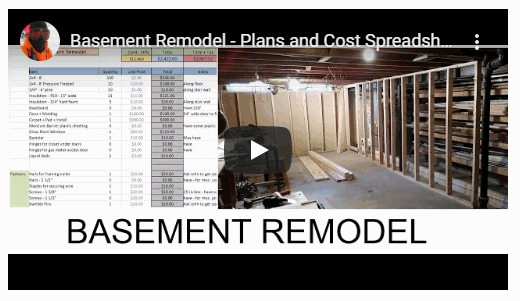Saving money on basement renovations doesn’t mean that you have to cut corners. You need to plan the steps out appropriately so that you can get what you want within reason. Here are some of the money-saving techniques that you can utilize in your basement project.
Decide On Wall Options
There are a variety of ways to finish your basement walls. The most obvious is to simply use normal 2×4 studs inside your concrete basement walls. Because these walls won’t be “load-bearing” the studs don’t have to be 16″ on center. You could save on materials by making them 24″ on center instead.
Plumbing and Electrical
Most of the plumbing and electrical work for your house should already be done so all you should need would be anything necessary for the basement itself. This might include an additional circuit breaker, some switches and outlets on the basement walls and perhaps a light fixture or two. Be sure to run all wiring before adding drywall. If you are adding a bathroom or laundry area you might have to do some additional plumbing. Be sure to consider the location carefully to lessen plumbing runs and be aware that normal toilets can’t flush up so the drains have to be lower than the toilets or you need a special toilet with a built-in pump.
Drop the Ceiling (or Not)
Finishing the ceiling may be one of your larger expenses because your services may need to be tucked up into the joists. Dropping the ceiling space when you have adequate headroom can save you some time and money involved in moving existing services. This will allow you to skip some of the costs of the finish work that would have been required if you’d decided to go with drywall on the ceiling. It will also reduce the amount of work that may be required to complete the job.
Another option, as done in the following video, is to go for the “industrial look” for your basement renovation and simply paint the ceiling joists and the area between them black which hides the stuff up there and actually makes the ceiling look taller. This is done in many commercial locations including restaurants and nightclubs.
Invest in Waterproofing
A basement should be dry if you plan on using it for living space. Taking the appropriate steps for basement waterproofing will save you money on mold and water intrusion issues in the future. Installing a sump pump is one of the most common means when it comes to keeping your basement dry. If you already have water issues be sure to take all the extra steps necessary to eliminate them BEFORE doing your basement renovations. There are other solutions that involve sealing the concrete through the use of specialized products, specialized drainage systems, adding plastic to the walls and other types of sealants.
Simplify the Finish
The level of finish that you want in your basement makes a huge difference when it comes to the amount of money that you’ll spend. For example, a tiled floor is going to require a larger budget than simply painting the concrete. There are special paints for the floor that can have fleck added to hide imperfections and seal out water. You may be able to get away with using waterproof paint on the concrete walls instead of finishing them out with drywall.
If you are going to use molding, consider buying the “contractor’s pack” which will give you bulk pricing and save you much more than buying the pieces individually.
As with many types of projects, planning ahead gives you the best chance of staying within your budget. Use these tips to get you started on keeping the costs low on your basement renovation.
Brooke Chaplan is a freelance writer and blogger. She lives and works out of her home in Los Lunas, New Mexico. She loves the outdoors and spends most of her time hiking, biking, and gardening. For more information, contact Brooke via Facebook at facebook.com/brooke.chaplan or Twitter @BrookeChaplan
You might also like:




